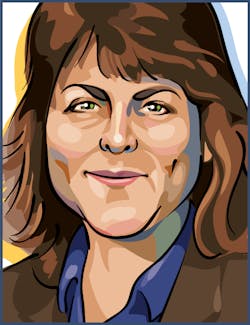With the morning presentations concluded, a pre-lunch panel on industrial lasers encouraged attendees of the 2015 Lasers & Photonics Marketplace Seminar (http://www.marketplaceseminar.com) to ask questions--any and all questions related to industrial laser markets and technologies. But as usual, audience questions got off to a slow start and were few.
Industrial lasers panel
Fortunately, panel moderator Mark Taggart, president of Laser Mechanisms, started with some introductory questions and statements by each of the panel members, including Silke Pflueger, general manager of DirectPhotonics, Ron Schaeffer, CEO of PhotoMachining, and Marianna Forrest, president of LasAp. As we described in our 2015 Annual Laser Market Review & Forecast in the January 2015 issue of Laser Focus World, Forrest recounted her early experience with lasers for body in white applications whereby she became somewhat of a pest to managers as she attempted to champion the use of lasers in numerous automotive applications.
At that time, lasers were expensive, complex, and in many cases, not able to compete with conventional mechanical processes. Fast-forward to 2015 and Forrest as well as other panel members agreed that this mentality in the industrial space no longer exists, thanks to laser advances that make them competitive and in many cases, the only solution in many manufacturing environments.
Among the industrial laser applications that the panel sees as growing in the coming years are rail-car manufacturing, automotive, especially for new carbon-reinforced fiber composites and aluminum bodies, and for small micromachining applications. The panel says that there is a lot of headroom for the penetration of laser technology for welding and brazing. For example, flatness specifications on many metallic components absolutely require the low-heat-affected zone of laser brazing and soldering. Also, Schaeffer noted that medical device processing applications emerge every day in his business. The panel also wanted to point out the companies like Apple and Google are hiring laser people as the trend continues towards the use of lasers in everything manufacturing related. These companies are recognizing that in-house laser expertise can accelerate the implementation of laser technology in the many manufacturing processes that are required for consumer electronics, gaming, and even wearable medical devices.
3D printing
This year, Laser Focus World had a lunchtime speaker talking about 3D printing--one of the hottest growth areas in photonics (and in non-photonic applications as well). While some audience members felt that a lunchtime speaker took away some of the valuable networking time at the conference, the presentation by John Dexheimer, president of LightWave Advisors, did not disappoint.
Dexheimer cited the McKinsey forecast that says the 3D printing industry will amount to $550 billion dollars by 2025. Even if lasers get 5% of that, Dexheimer exclaimed, that would be a huge windfall for laser manufacturers already in the 3D printing, additive manufacturing, laser sintering, or polymerization space, just to name a few aspects of the 3D printing business. One only needs to watch the GE nozzle video (see below) to see the benefits of moving from 18 individual parts down to one 3D printed component that requires no welding.
3D printing continues to gain favor in applications that seek more lightweight components with added functionality not possible using traditional subtractive processes. Compared to photonics, Dexheimer sees 3D printing as a more "vertical" business requiring hardware equipment, software, process control expertise, and distribution. Will stocks tumble like the telecom markets after the initial hype is over? Dexheimer doesn't think so--knowing that one of the strengths of 3D printing is the elimination not only of expensive tooling and molding costs, but the elimination of many post-processing steps that confound more traditional methods.
Executive panel
Once again moderated by Nufern president Martin Seifert, this year's executive panel featured Trevor Ness, Sr. VP global sales & marketing at IPG Photonics, David Allen, Sr. VP and GM of the lasers group at Newport Corporation, and Armin Renneisen, managing director of Rofin-Sinar. All the panelists, as in the morning panel, agreed that laser apprehension in the market is rapidly decreasing, with the low price and high reliability of lasers causing the total available market to grow each year.
IPG cited some new applications such as 50 kW lasers for pre-drilling of rock in oil and gas well applications. Most of the panelists agreed that such new applications are part of a diverse population of applications that mean lasers will never become the commodity that telecom components have succumbed to. IPG is most concerned that the myriad of new laser competitors (and government subsidies in places like China) could rip the value out of the market by artificial price drops (much as in the solar industry). Newport says that time is its biggest foe, meaning that it often takes too much time to develop new laser platforms and the applications move forward with existing competitors.
For this panel, the audience participation was a bit more lively than the morning panel. Valentin Gapontsev answered an audience question about what the theoretical limit was for fiber laser wall-plug efficiency. After much dialog, Gapontsev answered that it was 55 to 59% via fiber delivery. Newport still sees the laser industry as small in comparison to overall manufacturing, and says there is great potential for advancement and penetration as prices fall. Rofin-Sinar added that micromachining has the highest potential for growth due to applications that haven't even been discovered as yet.
Stay tuned to this blog site for my third blog in the series wherein I review the afternoon sessions at the 2015 Lasers & Photonics Marketplace Seminar (http://www.marketplaceseminar.com).

